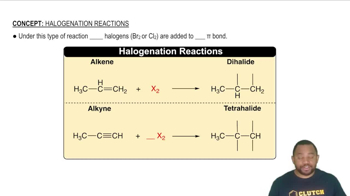Here are the essential concepts you must grasp in order to answer the question correctly.
Periodic Trends
Periodic trends refer to the predictable patterns observed in the properties of elements as you move across or down the periodic table. These trends include atomic radius, ionization energy, electronegativity, and reactivity. Understanding these trends helps explain why certain elements behave similarly and how their properties change with atomic number.
Recommended video:
Reactivity of Halogens
The reactivity of halogens is primarily influenced by their ability to gain electrons to achieve a stable electron configuration. The lightest halogen, fluorine, is highly reactive due to its small atomic size and high electronegativity, which allows it to attract electrons effectively. As you move down the group, the atomic size increases, leading to a decrease in electronegativity and a reduced ability to gain electrons, thus lowering reactivity.
Recommended video:
Atomic Size and Shielding Effect
Atomic size increases down a group in the periodic table due to the addition of electron shells. This increase in size results in a greater distance between the nucleus and the outermost electrons, which diminishes the nucleus's pull on these electrons. Additionally, the shielding effect, where inner electrons repel outer electrons, further reduces the effective nuclear charge felt by the outermost electrons, contributing to decreased reactivity in heavier halogens.
Recommended video:
 Verified step by step guidance
Verified step by step guidance

